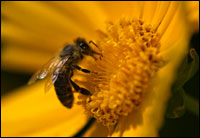This post marks the launch of Fork it Over, in which I (attempt to) answer questions inspired by my Victual Reality column. Got a question about food and the politics that surround it? Fork it over, by emailing it to victuals(at)grist(dot)org.

Reader Brooklynolmec writes in to inquire: are organically managed bees faring any better these days than their industrially farmed peers?
As most readers will know, the U.S. is currently in the grip of a widespread honeybee-colony collapse. Nationwide, something like a quarter of bee colonies have succumbed to what’s known as “colony collapse disorder,” in which bees abandon hives en masse, for unknown reasons, never to be seen again. In some areas, the collapse rate has reached as high as 70 percent, flummoxing scientists and endangering huge mono-cropped fields that rely on domesticated-bee pollination to fruit, like California’s super-sized almond groves.
But the answer to Brooklynolmec’s question is a qualified “yes”: Organic bee production is tricky these days — see below — but bees kept on a small scale, for honey to be consumed nearby, don’t seem to be dropping like, well, flies.
Organic honey production is tough. For one thing, for honey to be free of pesticide and other chemical residue, bees can’t forage on conventionally managed farm fields. Thus organic certification requires that hives not be placed within foraging range — about six miles — of conventional farms.
Than there’s the vexation of mites. In 1987, U.S. hives began to be infested with varroa mites, a bee parasite native to Asia. These pests are difficult to control organically, and have gotten only more so as large industrial beekeepers have attacked them with pesticides, causing them to mutate toward ever-hardier forms.
Even before the current collapse, varroa mites had already put serious pressure on domesticated bee populations, and nearly wiped out wild bees in some areas. Unhappily, varroa mites recently appeared for the first time in Hawaii, causing fears of the “the end of certified organic honey production on the island.”
Most of the small-scale beekeepers I know use formic acid (a substance produced naturally by ants to fend off parasites, but not allowed under organic code) to control mites.
Having said that, I’ve heard of very few cases of small-scale beekeepers experiencing the calamities now being visited upon the big guys. For the most part, colony collapse disorder has been limited to large operations that truck their hives cross country to “chase the bloom,” as it’s known. That is, vast mobile operations that make most of their cash not from honey but rather from for-hire pollination services in areas where mono-cropping and suburbanization have wiped out wild bees and small-scale bee keeping.
These growers tend to use high-fructose corn syrup to feed their bees while in transit — thus confirming yet again corn’s absolute centrality to industrial food production.
I’ve heard no convincing theory to explain the sudden collapse. All explanations so far — cell phones, crops genetically modified to contain pesticides, stress from travel, poor diet, mites — have been around for years, and can’t explain why bees are suddenly abandoning hives. But I do find it plausible that these factors compromise bees’ immune systems, making them more susceptible to whatever is causing the collapse.
Of course, the implications are enormous for industrial agriculture, a third of whose produce requires pollination. In the areas where industrial ag is most concentrated, natural pollinators have been killed off. If trucked honeybees follow suit, large-scale food production will become imperiled. Produce prices could surge.
The answer to this dire problem is delicious. Support your local foodshed — and give extra-special love to your local honey producers.



